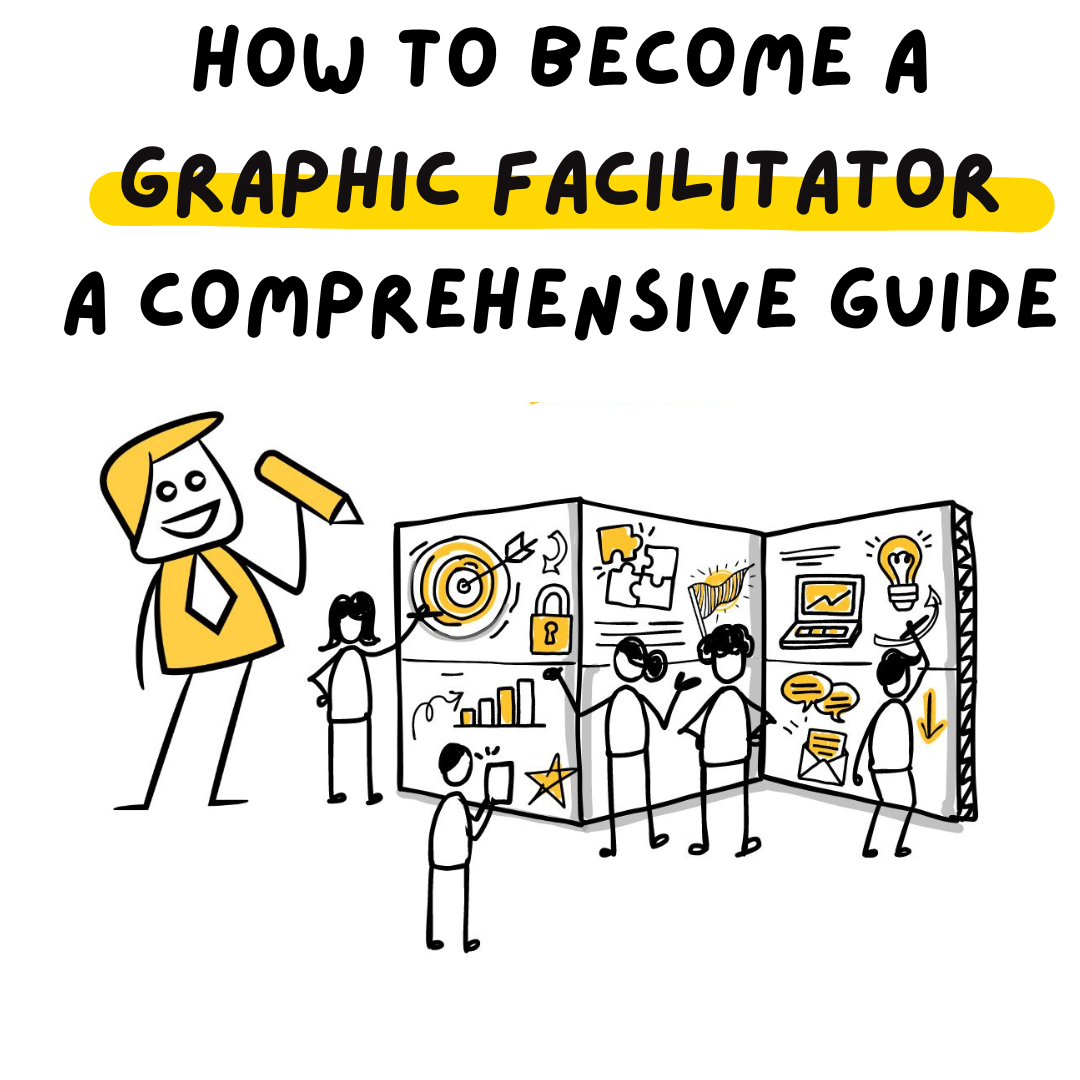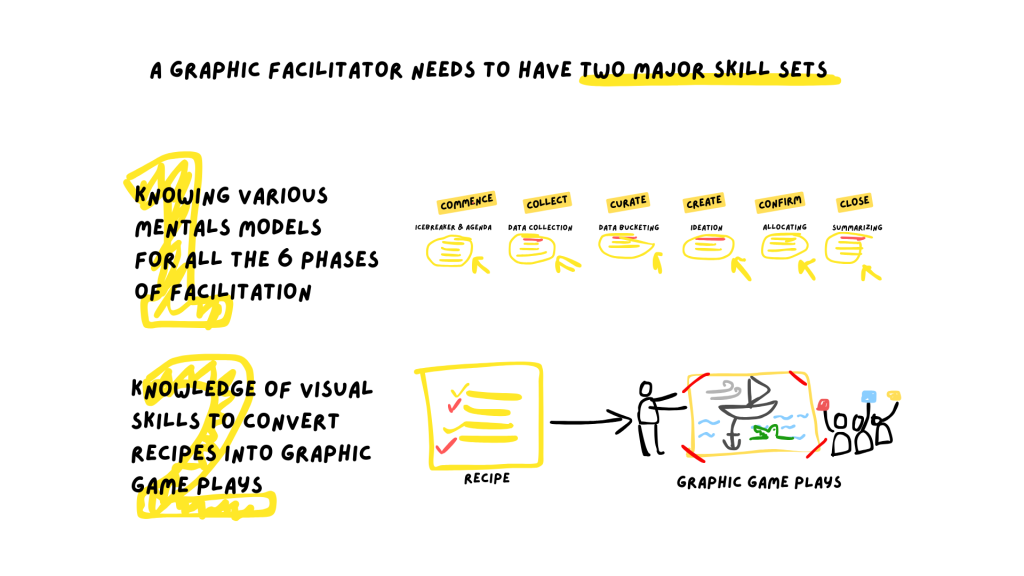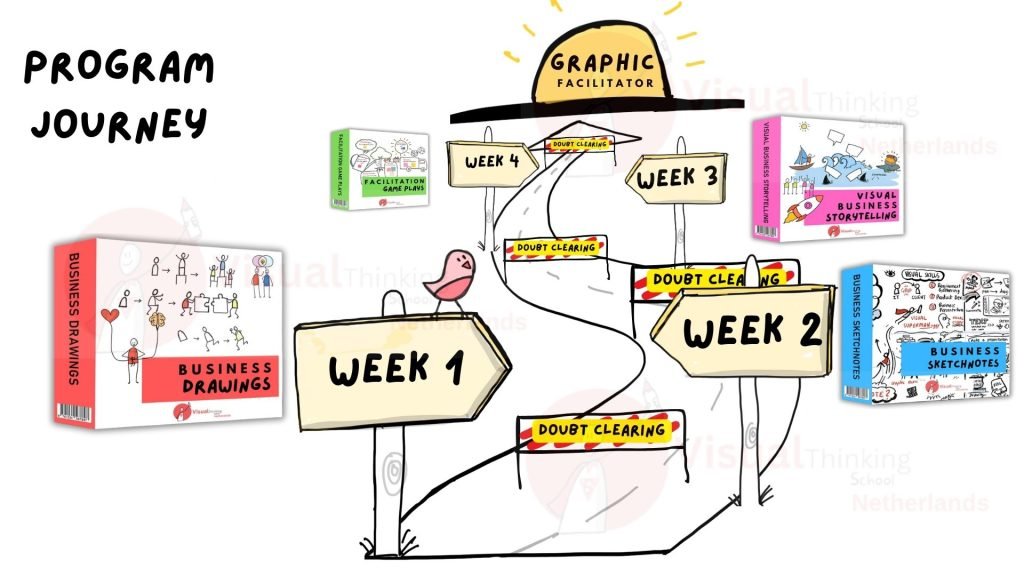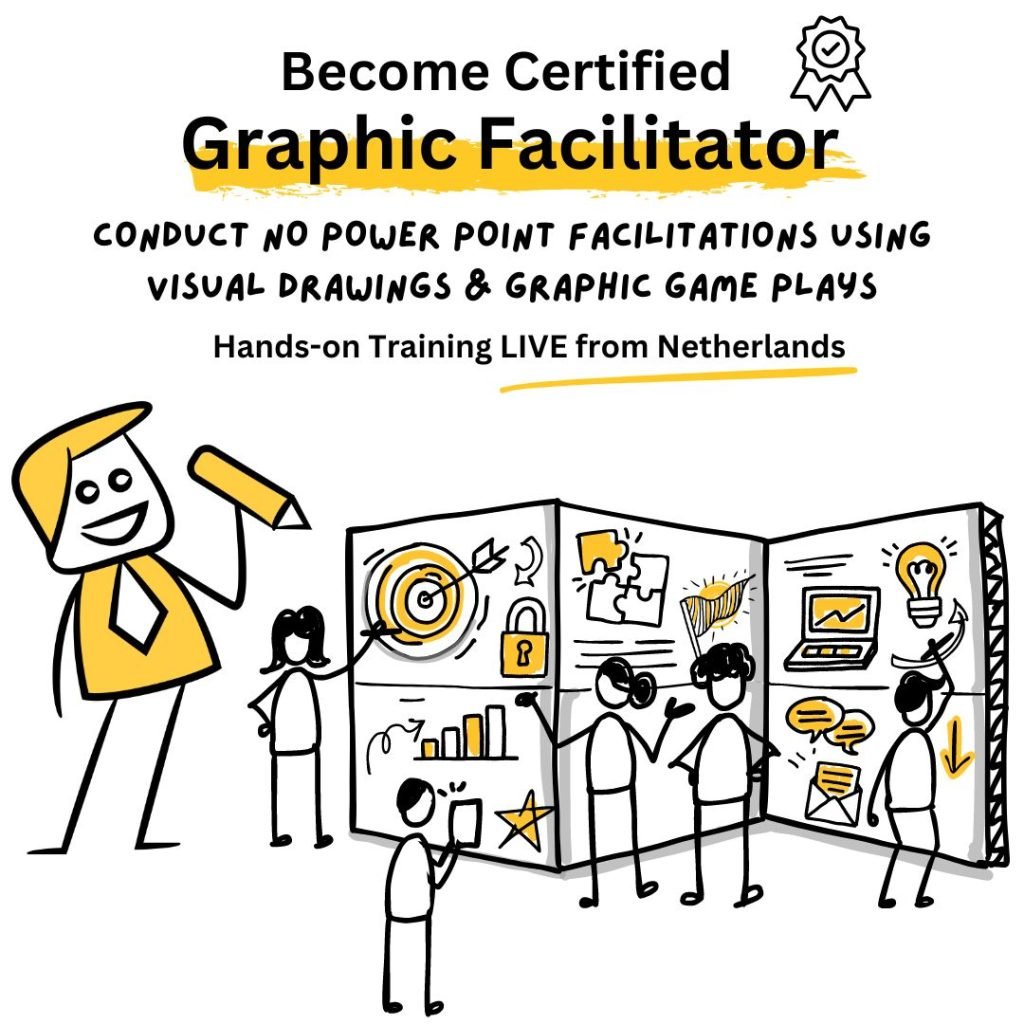
Topics covered in this article
When all the aspects of a facilitation session, training, coaching or a business meeting is conducted using hand sketches INSTEAD OF long texts, oral speeches and boring powerpoint slides.

A graphic facilitator is someone who uses visual thinking techniques, such as drawing, sketching, and graphic recording, to capture and communicate ideas, concepts, and discussions visually. They play a crucial role in facilitating meetings, workshops, brainstorming sessions, and other collaborative activities by creating visual representations that help participants understand and engage with the content more effectively.

😔Normal Facilitation :
😍 Graphic Facilitation
A graphic facilitator needs to master the following 4 visual skills in order to facilitate meetings and sessions using graphics (No Power Point Meetings)

A) Business Drawing: Visualizing complex business jargons with simple & engaging metaphorical drawings.

To go deeper into Business Drawing
– Business Drawing Masterclass
– Digital Icon and Metaphor Sets to Practice
B) Business Sketchnotes: Summarizing Meetings and Conferences with Visual Notes Taking Skills.

To go deeper into Business Sketchnotes
– full guide on how to Master Business Sketchnotes
– Download sketchnote templates
– Business Sketchnotes Masterclass
C) Visual Business Storytelling : Harvesting Facilitation Outcomes in the form of Metaphorical Visual Story Board.

Go deeper into Visual Business Storytelling
Visual Business Storytelling Masterclass
SketchStory 100+ Business Storytelling Templates
D) Facilitation Game Plays: Gamifying Facilitation Exercises and Mental Models using Graphic Game Plays.

Go deeper into facilitation game plays, check our 4 weeks Graphic Facilitation Certification program
Dividing Your Facilitation Session / Meeting into six phases. We call it the 6 C’s of Facilitation Bucket. These 6 phases are: Commence, Collect, Curate, Create, Confirm, Close.
At VisualThinkingSchool, we explain every thing using visual storytelling metaphors. Our 6C’s of facilitation bouquet is nothing but a how you will make a bouquet of flowers for your friend.

Lets understand this in brief.
1) Commence: You start the process by going in the garden (metaphorical) and thats what you do when you start a facilitation session with Graphic Icebreakers. We have many drawing based icebreaker game plays which you can conduct online or offline to give a very energetic start to your facilitation sessions.
2) Collect: You will now start collecting the flowers (metaphor) and thats what you do when you conduct data collection or brainstorm or experiencial data collection exercises. There are many graphic game plays under this section to help achieve this output.
3) Curate: Now when you have collected various flowers from the garden, you will not curate them by keeping different types of flowers in different pockets (metaphor). This is exactly how you bucket data which you collected in 2nd phase to make logical sense of the data. There are various methods like cluster mapping or empathy mapping to achieve this. In order to gamify it, method like dot voting and time box voting comes handy
4) Create: After curating different flowers in different pockets you will now create a unique bouquet by mixing the flowers (metaphor) Similary after curating and prioritizing data points, you will now start ideation process and talking about solution. Gamified methods like six thinking hat and many others like these comes handy.
5) Confirm: You put a name tag to your bouquet right ! So that you know to whom you will be gifting this (metaphor). Similarly to have a healthy outcome of your facilitation session, it is important that from all the generated ideas, we choose the most effective ones and also allocate ownership for those ideas. Graphically Gamified Eisenhover decision making matrix is an effective mental model for this.
6) Closing: Finally you gift it to the person you made this bouquet for (metaphor). Exactly the same way this is where we close the session by doing a summary exercise so that it reinforces the outcomes of the meeting in participants minds.
As you must have noticed, each of these 6 phases has many mental models (exercises) associated with it. An experienced graphic facilitator must know many game plays under each head.

Facilitator then chooses one mental model for each phase and makes a unique ‘facilitation recipe‘. This choice depends on

Facilitator then converts this facilitation recipe into graphic games for the final execution with the participants. This requires very strong hold on all the four visual skills explained above

Over all as you can see this requires a facilitator to know an indepth knowledge and experience of

We have designed a unique 4 weeks program on “Graphic Facilitation Certification” which constitutes of 31 hours of LIVE trainings from Netherlands. This covers all the four Visual Skills shared above.

Check program details >> Graphic Facilitation Certification

Join Our Graphic Facilitator Community to Learn for FREE


Piyuesh is the founder of Visual Thinking School, Netherlands. He is passionate about empowering organizations and classrooms with Visual Thinking Skills. He conducts trainings onBusiness Sketchnotes™ , Classroom Sketchnotes™, Visual Business Storytelling™, Graphic Facilitation™
In his free time, piyuesh likes practicing Aerial Yoga, Acro yoga, Krav Maga and Pole workouts.